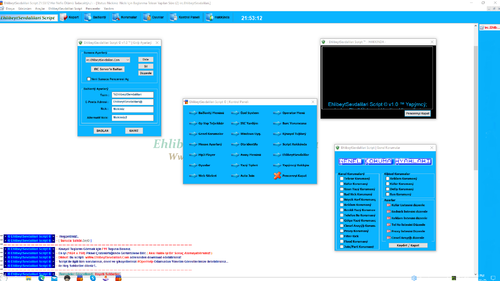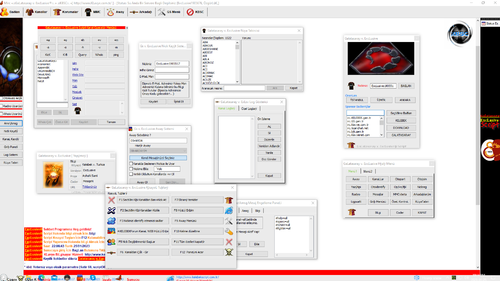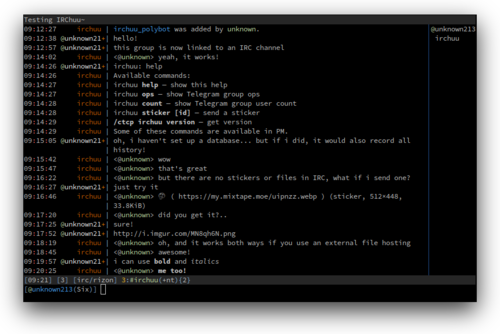-
Posts
580 -
Joined
-
Last visited
-
Days Won
7
Content Type
Profiles
Forums
Downloads
Gallery
Events
Articles
Files posted by coders-irc_Bot
-
Dll_Package
By coders-irc_Bot in DLL's
this is just some mirc dlls with the aliases already coded to them making this easier on coders for all networks who don't want to take the time to manually code each aliases so nothing over fantastic this time but every little helps i hope you enjoy this and i hope it helps you
0 downloads
(0 reviews)0 comments
Submitted
-
(0 reviews)
0 comments
Submitted
-
eggdrop-docker
By coders-irc_Bot in Botnet Scripts
eggdrop-docker
This is the Git repo for the official Docker image of Eggdrop, the Internet's oldest IRC bot still under active development. For information on how to properly configure and use the image, please see the official Egggdrop Docker Hub page.
0 downloads
(0 reviews)0 comments
Submitted
-
EhlibeytSevdalilari Script
By coders-irc_Bot in Turkish Scripts
Yasaklardan öldürmelere ve korumaya kadar birçok özelliğe sahip, her yönüyle iyi bir komut dosyası.
0 downloads
(0 reviews)0 comments
Submitted
-
(0 reviews)
0 comments
Submitted
-
(0 reviews)
0 comments
Submitted
-
GaLatasaray v. ExcLusive®
By coders-irc_Bot in Turkish Scripts
Yasaklardan öldürmelere ve korumaya kadar birçok özelliğe sahip, her yönüyle iyi bir komut dosyası.
4 downloads
(0 reviews)0 comments
Submitted
-
Gate Keeper 1.4
By coders-irc_Bot in Query Addons
DeluXe GateKeeper 1.4
ReadMe.txt 10-17-2012
By Neo Nemesis
mIRC 6.35, 7.25 OR HIGHER
THIS SCRIPT IS PROVIDED AS-IS.
Please use the command /blocker to access this script's
features and options.
INSTALLATION INSTRUCTIONS
1) DOWNLOAD & OPEN GateKeep.zip (or GakeKeep.rar)
2) EXTRACT THE FOLDER TITLED "DX" INTO YOUR mIRC DIRECTORY
3) RUN mIRC
4) USE THIS COMMAND IN mIRC: /load -rs DX\DXGKEEP.dxe
FEATURES
MAIN COMMAND: /blocker
^^ This command brings up the options dialog where you can
toggle your Gate Keeper.
Variable Settings, can be set to accept all messages, prompt
for permission first or ignore all messages.
Customizable event messages allow you to assign different
messages to accepted, declined, ignored and even more
messages.
Message prompt window color can be set to whatever color
you want with a drop down color combo box.
DIALOG WALK-THRU
Accept All Messages - This is basically the "off" setting
Prompt All Messages - This is basically the "on" setting.
A prompt window will pop up on your screen with the name,
and message from who ever is sending you a private message.
The prompt window has 3 options, Accept, Decline and Ignore.
Ignore All Messages - With this 3rd option enabled, the
script is niether on nor off, but is still running. It
automatically declines all incoming private messages until
you set it back to one of the previouw two settings.
Message Window Color - This allows you to set the color of
the prompt window that pops up when the script is in "Prompt
All Messages" mode.
Do Not Prompt For Users In My Notify List - Anyone in your
notify list is ignored by this script when this feature is
enabled.
Gate Keeper Messages - These messages are customizable for
the events in which the Gate Keeper handles. You can put
whatever you want there I suppose, but I didn't intend for
people to be rude about ignored or declined messages.
Thank you!
3 downloads
(0 reviews)0 comments
Updated
-
(0 reviews)
0 comments
Updated
-
GetWebFile.dll
By coders-irc_Bot in DLL's
This is much faster and more efficient than using mIRC sockets.
Use:
* Extract the zip file to your mircdir ( //echo -a $mircdir )
* Type /load -rs GetWebFile.mrc
* Try one of the examples
* /getmycarddeck (Will download card images)
* /getmyjokes (Will echo a Joke)
Example Scripts:
Example 1 Demonstrates how you can quickly download all the pictures needed for a script by downloading the images for a deck of cards.
Example 2 Demonstrates how you can use this dll instead of sockets to copy a web page to a file and parse the information.
Syntax $GetWebFile(http://full/path/to/filefilename.ext,Xestinationdirectoryincludingfilename.ext)
;**Note** that this dll will not create the destination directory for you.
;If the directory doesn't exist the transfer will fail!
alias GetWebFile {
if ($dll($GWFLocation,GetWebFile,$1 $2)) return 1
else return 0
}
;Syntax $GetWebHeader( http://full/path/to/filefilename.ext,Xestinationdirectoryincludingfilename.ext)
alias GetWebHeader {
if ($dll($GWFLocation,GetWebHeader,$1 $2)) return 1
else return 0
}
;*
;Edit this alias to reflect the location of GetWebFile.dll
alias GWFLocation return $qt($+($mircdir,GetWebFile.dll))
0 downloads
(0 reviews)0 comments
Submitted
-
hDock.dll
By coders-irc_Bot in DLL's
dock dlgs and @windows in toolbar/switchbar/treebar and $tip()
mirc 7+
0 downloads
(0 reviews)0 comments
Submitted
-
Hybrid Omega
By coders-irc_Bot in MSN Archive Scripts
One of the best publicly released msn script of all time. A must have for all msn script lovers
Updated to include mIRC 6.1.7, TG007 vincula, TG007 cookie grabber, and TGK's room creation.
No other changes were made.
13 downloads
Submitted
-
imgmirc.dll v0.29 beta
By coders-irc_Bot in DLL's
This dll ads emoticons to mirc. This version is a beta version built for mirc 7+
0 downloads
(0 reviews)0 comments
Updated
-
imgmirc.dll v0.29 beta
By coders-irc_Bot in DLL's
This dll ads emoticons to mirc. This version is a beta version built for mirc 7+
0 downloads
(0 reviews)0 comments
Submitted
-
(0 reviews)
0 comments
Submitted
-
irc-bot
By coders-irc_Bot in 0ld IRC Bots
An advanced and scriptable PHP IRC bot.
It is designed to run off a local LAMP, WAMP, MAMP stack or just plain PHP installation. No web server is required, only a working PHP installation.
System requirements
In order to run WildPHP, we ask a few things from your system. Notably:
A PHP version equal to or higher than 7.1.0. Command-line access to the system you plan on running WildPHP on. WildPHP will NOT run inside a web server like Apache or Nginx. Do not ask for support for doing so. WildPHP has been tested to work on Linux and macOS. Other platforms are not supported and not guaranteed to work. For the best experience, we recommend either using the included systemd service (adjust it to your needs) or using tmux or screen to allow the bot to run in the background. IRC Community & Support
If you need help or just want to idle in the IRC channel join us at #wildphp@irc.freenode.net. Development discussion in #wildphp-dev@irc.freenode.net.
Features and Functions
Right now this version of the bot is under heavy development, therefore the feature list is not definitive. We will update this once a reliable list becomes available.
Installation
To install the latest development build, you need Composer. Install WildPHP using the following commands:
$ git clone https://github.com/WildPHP/irc-bot $ cd irc-bot $ composer install This will pull all Composer dependencies required to run the bot.
Please note that the bot may be unstable and that it might not even start. Please file a bug if you encounter an issue!
Configuration
Copy the example configuration file and edit it to suit your needs. Carefully read the comments.
$ cp config/config.sample.php config/config.php Running the bot
While you can run the bot in a terminal it is best to run it in tmux or screen so that it can run in background.
$ php bin/wildphp.php Alternatively, a systemd service is included. Edit it (carefully read the comments), then drop it in /etc/systemd/system/. Issue a systemctl daemon-reload afterwards and you should be able to use the service.
Contributors
You can see the full list of contributors in the GitHub repository.
Major & Past Major Contributors
Super3 Pogosheep Matejvelikonja Yoshi2889 TimTims Amunak0 downloads
(0 reviews)0 comments
Submitted
-
(0 reviews)
0 comments
Updated
-
irc-rss-feed-bot
By coders-irc_Bot in 0ld IRC Bots
irc-rss-feed-bot
irc-rss-feed-bot is a dockerized Python 3.11 and IRC based RSS/Atom and scraped HTML/JSON/CSV feed posting bot. It essentially posts the entries of feeds in IRC channels, one entry per message. More specifically, it posts the titles and shortened URLs of entries.
Contents
Features Links Examples Development Usage Configuration: secret Configuration: non-secret Global settings Mandatory Recommended Developer Feed-specific settings Mandatory Optional Parser Conditional Feed default settings Commands Administrative Deployment Maintenance Service Config Database Disk cache Features
Multiple channels on an IRC server are supported, with each channel having its own set of feeds. For use with multiple servers, a separate instance of the bot process can be run for each server. Entries are posted only if the channel has not had any conversation for a certain minimum amount of time, thereby avoiding the interruption of any preexisting conversations. This amount of time is 15 minutes for any feed which has a polling period greater than 12 minutes. There is however no delay for any feed which has a polling period less than or equal to 12 minutes as such a feed is considered urgent. A SQLite database file records hashes of the entries that have been posted, thereby preventing them from being reposted. Posted URLs are shortened using the da.gd service. The hext, jmespath, and pandas DSLs are supported for flexibly parsing arbitrary HTML, JSON, and CSV content respectively. These parsers also support configurable recursive crawling. Entry titles are formatted for neatness. Any HTML tags and excessive whitespace are stripped, all-caps are replaced, and excessively long titles are sanely truncated. A TTL and ETag based compressed disk cache of URL content is used for preventing unnecessary URL reads. Any websites with a mismatched strong ETag are probabilistically detected, and this caching is then disabled for them for the duration of the process. Note that this detection is skipped for a weak ETag. Encoded Google News and FeedBurner URLs are decoded. For several more features, see the customizable global and feed-specific settings, and commands.
Links
Caption Link Repo https://github.com/impredicative/irc-rss-feed-bot Changelog https://github.com/impredicative/irc-rss-feed-bot/releases Image https://hub.docker.com/r/ascensive/irc-rss-feed-bot Examples
<FeedBot> [ArXiv:cs.AI] Concurrent Meta Reinforcement Learning → https://arxiv.org/abs/1903.02710v1 <FeedBot> [ArXiv:cs.AI] Attack Graph Obfuscation → https://arxiv.org/abs/1903.02601v1 <FeedBot> [InfoWorld] What is a devops engineer? And how do you become one? → https://da.gd/dvXh9 <FeedBot> [InfoWorld] What is Jupyter Notebook? Data analysis made easier → https://da.gd/yrCi <FeedBot> [AWS:OpenData] COVID-19 Open Research Dataset (CORD-19): Full-text and metadata dataset of COVID-19 research articles. → https://registry.opendata.aws/cord-19
Development
For software development purposes only, the project can be set up on Ubuntu as below.
make setup-ppa make install-py make setup-venv make shell make install make test make build Usage
Configuration: secret
Prepare a private secrets.env environment file using the sample below.
IRC_PASSWORD=YourActualPassword GITHUB_TOKEN=c81a62ca23caa140715bbfc175997c02d0fdd768 GITHUB_TOKEN
This is optional. Refer to the publish.github feature.
Configuration: non-secret
Prepare a version-controlled config.yaml file using the sample below. A full-fledged real-world example is also available.
host: irc.libera.chat ssl_port: 6697 #ssl_verify: true nick: MyFeedBot admin: mynick!myident@myhost alerts_channel: '#mybot-alerts' mode: #mirror: '#mybot-mirror' #publish: # github: MyGithubServiceAccountUsername/IrcServerName-MyBotName-live #defaults: # new: all feeds: "##mybot-alerts": irc-rss-feed-bot: url: https://github.com/impredicative/irc-rss-feed-bot/releases.atom period: 12 shorten: false "#some_chan1": AWS:OpenData: url: https://registry.opendata.aws/rss.xml message: summary: true CDC:FoodSafety: url: https://tools.cdc.gov/api/v2/resources/media/316422.rss redirect: true j:AJCN: url: https://academic.oup.com/rss/site_6122/3981.xml mirror: false period: 12 blacklist: title: - ^Calendar\ of\ Events$ LitCovid: url: https://www.ncbi.nlm.nih.gov/research/coronavirus-api/export pandas: |- read_csv(file, comment="#", sep="\t") \ .assign(link=lambda r: "https://pubmed.ncbi.nlm.nih.gov/" + r["pmid"].astype("str")) \ .convert_dtypes() MedicalXpress:nutrition: url: https://medicalxpress.com/rss-feed/search/?search=nutrition r/FoodNerds: url: https://www.reddit.com/r/FoodNerds/new/.rss shorten: false sub: url: pattern: ^https://www\.reddit\.com/r/.+?/comments/(?P<id>.+?)/.+$ repl: https://redd.it/\g<id> "##some_chan2": ArXiv:cs.AI: &ArXiv url: http://export.arxiv.org/rss/cs.AI period: 1.5 https: true shorten: false group: ArXiv:cs alerts: empty: false format: re: title: '^(?P<name>.+?)\.?\ \(arXiv:.+(?P<ver>v\d+)\ ' str: title: '{name}' url: '{url}{ver}' ArXiv:cs.NE: <<: *ArXiv url: http://export.arxiv.org/rss/cs.NE ArXiv:stat.ML: <<: *ArXiv url: http://export.arxiv.org/rss/stat.ML group: null AWS:status: url: https://status.aws.amazon.com/rss/all.rss period: .2 https: true new: none sub: title: pattern: ^(?:Informational\ message|Service\ is\ operating\ normally):\ \[RESOLVED\] repl: '[RESOLVED]' format: re: id: /\#(?P<service>[^_]+) str: title: '[{service}] {title} | {summary}' url: '{id}' Fb:Research: url: https://research.fb.com/publications/ hext: |- <div> <a href:link><h3 @text:title/></a> <div class="areas-wrapper"><a href @text:category/></div> </div> <div><form class="download-form" action/></div> whitelist: category: - ^(?:Facebook\ AI\ Research|Machine\ Learning|Natural\ Language\ Processing\ \&\ Speech)$ InfoWorld: url: https://www.infoworld.com/index.rss order: reverse j:MDPI:N: # https://www.mdpi.com/journal/nutrients (open access) url: https://www.mdpi.com/rss/journal/nutrients www: false KDnuggets: url: https://us-east1-ml-feeds.cloudfunctions.net/kdnuggets new: some libraries.io/pypi/scikit-learn: url: https://libraries.io/pypi/scikit-learn/versions.atom new: none period: 8 shorten: false MedRxiv: url: - https://connect.medrxiv.org/medrxiv_xml.php?subject=Health_Informatics - https://connect.medrxiv.org/medrxiv_xml.php?subject=Nutrition alerts: read: false https: true r/MachineLearning:100+: url: https://www.reddit.com/r/MachineLearning/hot/.json?limit=50 jmespath: 'data.children[*].data | [?score >= `100`].{title: title, link: join(``, [`https://redd.it/`, id])}' shorten: false r/wallstreetbets:50+: url: https://www.reddit.com/r/wallstreetbets/hot/.json?limit=98 jmespath: 'data.children[*].data | [?(not_null(link_flair_text) && score >= `50`)].{title: join(``, [`[`, link_flair_text, `] `, title]), link: join(``, [`https://redd.it/`, id]), category: link_flair_text}' emoji: false shorten: false blacklist: category: - ^(?:Daily\ Discussion|Gain|Loss|Meme|Weekend\ Discussion|YOLO)$ PwC:Latest: url: https://us-east1-ml-feeds.cloudfunctions.net/pwc/latest period: 0.5 dedup: channel PwC:Trending: url: https://us-east1-ml-feeds.cloudfunctions.net/pwc/trending period: 0.5 dedup: channel SeekingAlpha: period: 0.2 sub: url: pattern: ^(?P<main_url>https://seekingalpha\.com/[a-z]+/[0-9]+).*$ repl: \g<main_url> shorten: false topic: "Daily calendar": \b(?i:economic\ calendar)\b "Daily prep": '^Wall\ Street\ Breakfast:\ ' "Hourly status": ^On\ the\ hour$ url: - https://seekingalpha.com/market_currents.xml - https://seekingalpha.com/feed.xml - https://seekingalpha.com/tag/etf-portfolio-strategy.xml - https://seekingalpha.com/tag/wall-st-breakfast.xml SSRN: url: https://papers.ssrn.com/sol3/Jeljour_results.cfm?form_name=journalBrowse&journal_id=3526423&Network=no&lim=false&npage=1 hext: select: <a href:link href^="https://ssrn.com/abstract=" @text:title /> follow: <a class="jeljour_pagination_number" @text:prepend("https://papers.ssrn.com/sol3/Jeljour_results.cfm?form_name=journalBrowse&journal_id=3526423&Network=no&lim=false&npage="):url/> period: 6 TalkRL: url: https://www.talkrl.com/feed period: 8 message: title: false summary: true YT:3Blue1Brown: &YT url: https://www.youtube.com/feeds/videos.xml?channel_id=UCYO_jab_esuFRV4b17AJtAw period: 12 shorten: false style: name: bg: red fg: white bold: true sub: url: pattern: ^https://www\.youtube\.com/watch\?v=(?P<id>.+?)$ repl: https://youtu.be/\g<id> YT:AGI: url: https://www.youtube.com/results?search_query=%22artificial+general+intelligence%22&sp=CAISBBABGAI%253D hext: <a href:filter("/watch\?v=(.+)"):prepend("https://youtu.be/"):link href^="/watch?v=" title:title/> period: 12 shorten: false alerts: emptied: true blacklist: title: - \bWikipedia\ audio\ article\b YT:LexFridman: <<: *YT url: https://www.youtube.com/feeds/videos.xml?channel_id=UCSHZKyawb77ixDdsGog4iWA whitelist: title: - \bAGI\b Global settings
Mandatory
host: IRC server address. ssl_port: IRC server SSL port. ssl_verify: If false, the TLS/SSL certificate is not verified. Its default is true. nick: This is a registered IRC nick. If the nick is in use, it will be regained. Ensure that the email verification of the registered nick, as applicable to many IRC servers, is complete. Without this email verification being completed, the bot can fail to receive the required event 900 and therefore fail to function. Recommended
admin: Administrative commands by this user pattern are accepted and executed. Its format is nick!ident@host. An example is JDoe11!sid654321@gateway/web/irccloud.com/x-*. A case-insensitive pattern match is tested for using fnmatch. alerts_channel: Some but not all warning and error alerts are sent to this channel. Its default value is ##{nick}-alerts. The key {nick}, if present in the value, is formatted with the actual nick. For example, if the nick is MyFeedBot, alerts will by default be sent to ##MyFeedBot-alerts. Since a channel name starts with #, the name if provided must be quoted. It is recommended that the alerts channel be registered and monitored. mode: This can for example be +igR for Libera and +igpR for Rizon. Optional
mirror: If specified as a channel name, all posts across all channels are mirrored to this channel. This however doubles the time between consecutive posts in any given channel. Mirroring can however individually be disabled for a feed by setting <feed>.mirror. publish.github: This is the username and repo name of a GitHub repo, e.g. feedarchive/libera-feedbot-live. All posts are published to the repo, thereby providing a basic option to archive them. A new CSV file is written to the repo for each posted feed having one or more new posts. The following requirements apply: The repo must exist; it is not created by the bot. It is recommended that an empty new repo is used. If the repo is of public interest, it can be requested to be moved into the feedarchive organization by filing an issue. The GitHub user must have access to write to the repo. It is recommended that a dedicated new service account be used, not your primary user account. A GitHub personal access token is required with access to the entire repo scope. The repo scope is used for making commits. The token is provisioned for the bot via the GITHUB_TOKEN secret environment variable. Developer
log.irc: If true, low level IRC events are logged by miniirc. These are quite noisy. Its default is false. once: If true, each feed is queued only once. It is for testing purposes. Its default is false. tracemalloc: If true, memory allocation tracing is enabled. The top usage and positive-diff statistics are then logged hourly. It is for diagnostic purposes. Its default is false. Feed-specific settings
A feed is defined under a channel as in the sample configuration. The feed's key represents its name.
The order of execution of the interacting operations is: redirect, blacklist, whitelist, https, www, emoji, sub, format, shorten. Refer to the sample configuration for usage examples.
YAML anchors and references can be used to reuse nodes. Examples of this are in the sample.
Mandatory
<feed>.url: This is either a single URL or a list of URLs of the feed. If a list, the URLs are read in sequence with an interval of one second between them. Optional
These are optional and are independent of each other:
<feed>.alerts.empty: If true, an alert is sent if any source URL of the feed has no entries before their validation. If false, such an alert is not sent. Its default value is true. <feed>.alerts.emptied: If true, an alert is sent if the feed has entries before but not after their validation. If false, such an alert is not sent. Its default value is false. <feed>.alerts.read: If true, an alert is sent if an error occurs three or more consecutive times when reading or processing the feed, but no more than once every 15 minutes. If false, such an alert is not sent. Its default value is true. <feed>.blacklist.category: This is an arbitrarily nested dictionary or list or their mix of regular expression patterns that result in an entry being skipped if a search finds any of the patterns in any of the categories of the entry. The nesting permits lists to be creatively reused between feeds via YAML anchors and references. <feed>.blacklist.title: This is an arbitrarily nested dictionary or list or their mix of regular expression patterns that result in an entry being skipped if a search finds any of the patterns in the title. The nesting permits lists to be creatively reused between feeds via YAML anchors and references. <feed>.blacklist.url: Similar to <feed>.blacklist.title. <feed>.dedup: This indicates how to deduplicate posts for the feed, thereby preventing them from being reposted. The default value is feed (per-feed per-channel), and an alternate possible value is channel (per-channel). <feed>.emoji: If false, emojis in entry titles are removed. Its default value is null. <feed>.group: If a string, this delays the processing of a feed that has just been read until all other feeds having the same group are also read. This encourages multiple feeds having the same group to be be posted in succession, except if interrupted by conversation. It is however possible that unrelated feeds of any channel gets posted between ones having the same group. To explicitly specify the absence of a group when using a YAML reference, the value can be specified as null. It is recommended that feeds in the same group have the same period. <feed>.https: If true, entry links that start with http:// are changed to start with https:// instead. Its default value is false. <feed>.message.summary: If true, the entry summary (description) is included in its message. The entry title, if included, is then formatted bold. This is applied using IRC formatting if a style is defined for the feed, otherwise using unicode formatting. The default value is false. <feed>.message.title: If false, the entry title is not included in its message. Its default value is true. <feed>.mirror: If false, mirroring is disabled for this feed. Its default value is true, subject to the global-setting for mirroring. <feed>.new: This indicates up to how many entries of a new feed to post. A new feed is defined as one with no prior posts in its channel. The default value is some which is interpreted as 3. The default is intended to limit flooding a channel when one or more new feeds are added. A string value of none is interpreted as 0 and will skip all entries for a new feed. A value of all will skip no entries for a new feed; it is not recommended and should be used sparingly if at all. In any case, future entries in the feed are not affected by this option on subsequent reads, and they are all forwarded without a limit. <feed>.order: If reverse, the order of the entries is reversed. <feed>.period: This indicates how frequently to read the feed in hours on an average. Its default value is 1. Conservative polling is recommended. Any value below 0.2 is changed to a minimum of 0.2. Note that 0.2 hours is equal to 12 minutes. To make service restarts safer by preventing excessive reads, the first read is delayed by half the period. To better distribute the load of reading multiple feeds, a uniformly distributed random ±5% is applied to the period for each read. <feed>.redirect: This indicates whether to substitute each entry URL with its redirect target. The default value is false. <feed>.shorten: This indicates whether to post shortened URLs for the feed. The default value is true. The alternative value false is recommended if the URL is naturally small, or if sub or format can be used to make it small. If a "Blacklisted long URL" error is experienced for a reasonable website which should not be blacklisted, it can be reported here, using this issue as an example. <feed>.style.name.bg: This is a string representing the name of a background color applied to the feed's name. It can be one of: white, black, blue, green, red, brown, purple, orange, yellow, lime, teal, aqua, royal, pink, grey, silver. The channel modes must allow formatting for this option to be effective. <feed>.style.name.bold: If true, bold formatting is applied to the feed's name. Its default value is false. The channel modes must allow formatting for this option to be effective. <feed>.style.name.fg: Foreground color similar to <feed>.style.name.bg. <feed>.topic: This updates the channel topic with the short URL of a matching entry. It requires auto-op (+O) to allow the topic to be updated. The topic is divided into logical sections separated by | (<space><pipe><space>). For any matching entry, only its matching section in the topic is updated. Its value can be a dictionary in which each key is a section name and each value is a regular expression pattern. If a regular expression search matches an entry's title, the section in the topic is updated with the entry's short URL. The topic's length is not checked. <feed>.whitelist.category: This is an arbitrarily nested dictionary or list or their mix of regular expression patterns that result in an entry being skipped unless a search finds any of the patterns in any of the categories of the entry. The nesting permits lists to be creatively reused between feeds via YAML anchors and references. <feed>.whitelist.explain: This applies only to <feed>.whitelist.title. It can be useful for understanding which portion of a post's title matched the whitelist. If true, the first match of each posted title is italicized. This is applied using IRC formatting if a style is defined for the feed, otherwise using unicode formatting. For example, "This is a matching sample title". The default value is false. <feed>.whitelist.title: This is an arbitrarily nested dictionary or list from which all leaf values are used. The leaf values are regular expression patterns. This result in an entry being skipped unless a search finds any of the patterns in the title. The nesting permits lists to be creatively reused between feeds via YAML anchors and references. <feed>.whitelist.url: Similar to <feed>.whitelist.title. <feed>.www: If false, entry links that contain the www. prefix are changed to remove this prefix. Its default value is null. Parser
For a non-XML feed, one of the following non-default parsers can be used. Multiple parsers cannot be used for a feed. The parsers are searched for in the alphabetical order listed below, and the first to be found is used. Each parsed entry must at a minimum return a title, a link, an optional summary (description), and zero or more values for category The title can be a string or a list of strings.
<feed>.hext: This is a string representing the hext DSL for parsing a list of entry dictionaries from an HTML web page. Before using, it can be tested in the form here. Note that max_searches is set to 100_000 to protect against resource exhaustion. <feed>.jmespath: This is a string representing the jmespath DSL for parsing a list of entry dictionaries from JSON. Before using, it can be tested in the form here. <feed>.pandas: This is a string command evaluated using pandas for parsing a dataframe of entries. The raw content is made available to the parser as a file-like object named file. This parser uses eval which is unsafe, and so its use must be confirmed to be safe. The provisioned packages are json, numpy (as np), and pandas (as pd). The value requires compatibility with the versions of pandas and numpy defined in requirements.txt, noting that these version requirements are expected to be routinely updated. For recursive crawling, the value of a parser can alternatively be:
<feed>.<parser>.select: This is the string which was hitherto documented as the value for <feed>.<parser>.. The parser uses it to return the entries to post. <feed>.<parser>.follow: The is an optional string which the parser uses to return zero or more additional URLs to read. The returned URLs can a list of strings or a list of dictionaries with the key url. Crawling applies recursively to each returned URL. Each unique URL is read once. There is an interval of at least one second between the end of a read and the start of the next read. Care should nevertheless be taken to avoid crawling a large number of URLs. Some sites require a custom user agent or other custom headers for successful scraping; such a customization can be requested by creating an issue.
Conditional
The sample configuration above contains examples of these:
<feed>.format.re.title: This is a single regular expression pattern that is searched for in the title. It is used to collect named key-value pairs from the match if there is one. <feed>.format.re.url: Similar to <feed>.format.re.title. <feed>.format.str.title: The key-value pairs collected using <feed>.format.re.title and <feed>.format.re.url, both of which are optional, are combined along with the default additions of title, url, categories, and feed.url as keys. Any additional keys returned by the parser are also available. The key-value pairs are used to format the provided quoted title string. If the title formatting fails for any reason, a warning is logged, and the title remains unchanged. The default value is {title}. <feed>.format.str.url: Similar to <feed>.format.str.title. The default value is {url}. If this is specified, it can sometimes be relevant to set shorten to false for the feed. <feed>.sub.summary.pattern: This is a single regular expression pattern that if found results in the entry summary being substituted. <feed>.sub.summary.repl: If <feed>.sub.summary.pattern is found, the entry summary is replaced with this replacement, otherwise it is forwarded unchanged. <feed>.sub.title.pattern: Similar to <feed>.sub.summary.pattern. <feed>.sub.title.repl: Similar to <feed>.sub.summary.repl. <feed>.sub.url.pattern: Similar to <feed>.sub.summary.pattern. If a pattern is specified, it can sometimes be relevant to set shorten to false for the feed. <feed>.sub.url.repl: Similar to <feed>.sub.summary.repl. Feed default settings
A global default value can optionally be set under defaults for some feed-specific settings, namely new and shorten. This value overrides its internal default. It facilitates not having to set the same value individually for many feeds.
Refer to "Feed-specific settings" for the possible values and internal defaults of these settings. Refer to the embedded sample configuration for a usage example.
Commands
Commands can be sent to the bot either as a private message or as a directed public message. Private messages may however be prohibited for security purposes using the mode configuration. Public messages to the bot must be directed as MyBotNick: my_command.
Administrative
Administrative commands are accepted from the configured admin. If admin is not configured, the commands are not processed. It is expected but not required that administrative commands to the bot will typically be sent in the alerts_channel. The supported commands are:
exit: Gracefully exit with code 0. The exit is delayed until any feeds that are currently being posted finish posting and being written to the database. If running the bot as a Docker Compose service, using this command with restart: on-failure will (due to code 0) prevent the bot from automatically restarting. Note that a repeated invocation of this command has no effect. fail: Similar to exit but with code 1. If running the bot as a Docker Compose service, using this command with restart: on-failure will (due to a nonzero code) cause the bot to automatically be restarted. quit: Alias of exit. Deployment
As a reminder, it is recommended that the alerts channel be registered and monitored.
It is recommended that the bot be auto-voiced (+V) in each channel. Failing this, messages from the bot risk being silently dropped by the server. This is despite the bot-enforced limit of two seconds per message across the server.
It is recommended that the bot be run as a Docker container using using Docker ≥18.09.2, possibly with Docker Compose ≥1.24.0. To run the bot using Docker Compose, create or add to a version-controlled docker-compose.yml file such as:
version: '3.7' services: irc-rss-feed-bot: container_name: irc-rss-feed-bot image: ascensive/irc-rss-feed-bot:<VERSION> # network_mode: host # If having DNS name resolution issues. restart: on-failure # restart: always logging: options: max-size: 2m max-file: "5" volumes: - ./irc-rss-feed-bot:/config env_file: - ./irc-rss-feed-bot/secrets.env environment: TZ: America/New_York # Select TZ database name from https://en.wikipedia.org/wiki/List_of_tz_database_time_zones In the above service definition in docker-compose.yml:
image: Use a specific versioned tag, e.g. 0.12.0. volumes: Customize the relative path to the previously created config.yaml file, e.g. ./irc-rss-feed-bot. This volume source directory must be writable by the container using the UID defined in the Dockerfile; it is 999. A simple way to ensure it is writable is to run a command such as chmod -R a+w ./irc-rss-feed-bot once on the host. env_file: Customize the relative path to secrets.env. environment: Optionally customize the environment variable TZ to the preferred time zone as represented by a TZ database name. Note that the date and time are prefixed in each log message. From the directory containing docker-compose.yml, run docker-compose up -d irc-rss-feed-bot. Use docker logs -f irc-rss-feed-bot to see and follow informational logs.
Maintenance
Service
It is recommended that the supported administrative commands be used together with Docker Compose or a comparable container service manager to shutdown or restart the service.
Config
If config.yaml is updated, the container must be restarted to use the updated file. If secrets.env or the service definition in docker-compose.yml are updated, the container must be recreated (and not merely restarted) to use the updated file. Database
A posts.v2.db database file is written by the bot in the same directory as config.yaml. This database file must be preserved with routine backups. After restoring a backup, before starting the container, ensure the database file is writable by running a command such as chmod a+w ./irc-rss-feed-bot/posts.v2.db. The database file grows as new posts are made. For the most part this indefinite growth can be ignored. Currently, the standard approach for handling this, if necessary, is to stop the bot and delete the database file if it has grown unacceptably large. Restarting the bot after deleting the database will then create a new database file, and all configured feeds will be handled as new. This deletion is however discouraged as a routine measure. Disk cache
An ephemeral directory /app/.ircrssfeedbot_cache is written by the bot in the container. It contains one or more independent disk caches. The size of each independent disk cache in this directory is limited to approximately 2 GiB. If needed, this directory can optionally be mounted as an external volume.0 downloads
(0 reviews)0 comments
Submitted
-
irc3
By coders-irc_Bot in 0ld IRC Bots
A pluggable irc client library based on python's asyncio.
Requires python 3.5+
Python 2 is no longer supported, but if you don't have a choice you can use an older version:
$ pip install "irc3<0.9" Source: https://github.com/gawel/irc3/
Docs: https://irc3.readthedocs.io/
Irc: irc://irc.freenode.net/irc3 (www)
I've spent hours writing this software, with love. Please consider tipping if you like it:
BTC: 1PruQAwByDndFZ7vTeJhyWefAghaZx9RZg
ETH: 0xb6418036d8E06c60C4D91c17d72Df6e1e5b15CE6
LTC: LY6CdZcDbxnBX9GFBJ45TqVj8NykBBqsmT
0 downloads
(0 reviews)0 comments
Submitted
-
irchuu
By coders-irc_Bot in 0ld IRC Bots
Features
Relays messages between a Telegram (super)group and an IRC channel Lightweight, written in Go. Consumes only around 10MiB RAM! IRC authentication using SASL or NickServ (optional) Keeps log of the chat in a PostgreSQL database (those who recently joined the IRC channel can view history!) Preserves markup: bold in Telegram will remain bold in IRC All Telegram media types support; serves or uploads files so they are accessible in IRC All Telegram features like forwards, replies and edits are also supported Coloured nicknames in IRC (optional) Telegram group administrators can moderate the IRC channel and vice versa ...and this is not a complete list! Setup
Installation
You need to install golang, git and configure your $GOPATH. Just set $GOPATH environment variable to a writable directory and add $GOPATH/bin to your system $PATH.
After that, install IRChuu~:
$ go get github.com/26000/irchuu/... Upgrade with:
$ go get -u github.com/26000/irchuu/... Configuration
Run IRChuu~ for the first time and it will create a configuration file (you can also use -data and -config command-line arguments to specify a custom path):
$ irchuu IRChuu! v0.6.0 (https://github.com/26000/irchuu) 2017/04/01 15:26:03 New configuration file was populated. Edit /home/26000/.config/irchuu.conf and run `irchuu` again! Now edit the configuration file with your favourite editor (mine is vim, but I thought nano is more popular. Alternatively, you can just use a GUI editor like Kate):
$ nano ~/.config/irchuu.conf The variables you must set are:
token, group in the [telegram] section server, port, ssl, nick and channel in the [irc] section probably serverpassword, password, sasl and chanpassword for IRC authentication If you don't know where to get the Telegram token and groupname, refer to the next section.
Others are completely optional. The configuration file is well-documented, but if you have problems, feel free to open an issue on GitHub.
Telegram bot setup
For IRChuu to work, you will need to create a Telegram bot as it works through the Telegram bot API. This is pretty simple:
Message @botfather inside Telegram. Send /newbot command. It will ask some questions, answer all of them. You will have to think of a name and a nickname for your bot. @botfather will send you a token. Insert it into your configuration file. Type /setprivacy and choose your newly created bot nickname on the inline keyboard. Then choose Disable. This is important! If you forget to do it, messages from Telegram won't be relayed to IRC. Optionally, type /setuserpic and upload a cute picure for your relay Add your bot to your Telegram group (Add members and type the bot username there) Launch IRChuu~ (just type irchuu in console once more) Your bot will leave a message with the group id. That's totally ok, just copy the id into your config file, stop IRChuu (hit Ctrl+C in the terminal where IRChuu~ is running) All set, now just launch IRChuu for the third time and enjoy! IRC setup
This one is easier. You can just insert your server and channel addresses into your configuration file and choose a nickname. If that nickname is already taken, IRChuu will think of a new one. If you want to own that nickname so that nobody takes it, register it and enter the password in the configuration file. Refer to your server's NickServ focumentation for details.
Usage
Just type irchuu.
Contributing
Feel free to fork this repo and make PRs. If you encounter a bug, please open an issue — that also helps! I will also be happy if you give IRChuu a star on GitHub.
0 downloads
(0 reviews)0 comments
Submitted
-
irclogger
By coders-irc_Bot in 0ld IRC Bots
This is an IRC logger with a webinterface. To install, create a new MySQL table using the provided 'mysql.sql' script and edit the 'irclog.config.php' to match your database and IRC channel settings. Then run the 'irclog.pl -s' script to start logging. The logger needs the following perl modules: POE::Component::IRC Digest::MD5 DBI::mysql0 downloads
(0 reviews)0 comments
Submitted
-
Japanese-Tools
By coders-irc_Bot in 0ld IRC Bots
These are some scripts that help me learn Japanese.
Most scripts are supposed to be used as plugins for an IRC bot or run on a shell. I find the following aliases quite useful:
alias ja="$JAPANESE_TOOLS/jmdict/jm.sh" alias wa="$JAPANESE_TOOLS/jmdict/wa.sh" alias rtk="$JAPANESE_TOOLS/rtk/rtk.sh" alias gd="$JAPANESE_TOOLS/google_dictionary/gd.sh" I do most of my dictionary lookups with these aliases.
All scripts have only been tested on Ubuntu 12.04 and later. There are a few dependencies not present on a default Ubuntu system. You can install them with
$ sudo apt install mecab-jumandic-utf8 mecab kakasi xmlstarlet xsltproc python-irclib sqlite3 bc liburi-perl tesseract-ocr imagemagick audio/
find_audio.sh finds an audio version of a given Japanese word on languagepod101.
$ ./find_audio.sh 夜空 Audio for 夜空 [よぞら]: http://tinyurl.com/p8aq8jo compare_encoding
Compares the size of different encodings of the same Japanese Wikipedia article. In almost all cases UTF-8 is smaller than UTF-16.
$ ./compare_encoding.sh 夜空 UTF-8 vs. UTF-16: 91213 vs. 156876 bytes. UTF-8 wins by 41.8%. gettext/
Internationalization support. Currently supported languages:
English German Polish Be sure to run gettext/regenerate_mo_files.sh if you would like to use a translation.
google_count
Counts the number of Google results. Uses google.co.jp for queries containing Japanese characters and google.com otherwise.
google_dictionary/
gd.sh looks up English words in the Google dictionary.
$ ./gd.sh diligent /ˈdiləjənt/ having or showing care and conscientiousness in one's work or duties Currently broken because it appears like Google shut down their dictionary JSON API.
google_translate/
gt.sh translates words and sentences using Google Translate. The target language is determined by the environment variable LANG, but it can also be specified explicitly.
./gt.sh My hovercraft is full of eels. 私のホバークラフトは鰻がいっぱいです。 ./gt.sh it My hovercraft is full of eels. it: Il mio hovercraft è pieno di anguille. ./gt.sh Il mio hovercraft è pieno di anguille. My hovercraft is full of eels. Currently broken because Google shut down the translate API.
jmdict/
jm.sh provides jmdict lookups and wa.sh wadoku lookups. Works best for Japanese->English (or Japanese->German), not so well for the reverse direction. This is because jmdict is a Japanese English dictionary and not an English Japanese dictionary.
To start, you first need to run the scripts prepare_jmdict.sh and prepare_wadoku.sh. This will download and process the respective dictionary files.
$ ./jm.sh 村長 村長 [そんちょう] (n), village headman 市長村長選挙 [しちょうそんちょうせんきょ] (n), mayoral election kana/
A simple hiragana and katakana trainer.
Example IRC session
<Christoph> !hira help <nihongobot> Start with "!hira <level> [count]". Known levels are 0 to 10. To learn more about some level please use "!hira help <level>". <nihongobot> To only see the differences between consecutive levels, please use "!hira helpdiff <level>". <Christoph> !hira 5 <nihongobot> Please write in romaji: す と に ね へ <Christoph> !hira su to ni ne he <nihongobot> Perfect! 5 of 5. Statistics for Christoph: 44.64% of 280 characters correct. <nihongobot> Please write in romaji: は と ぬ ほ な kanjidic/
Implements a lookup in kanjidic: http://www.csse.monash.edu.au/~jwb/kanjidic.html
$ ./kanjidic.sh 日本語 日: 4 strokes. ニチ, ジツ, ひ, -び, -か. In names: あ, あき, いる, く, くさ, こう, す, たち, に, にっ, につ, へ {day, sun, Japan, counter for days} 本: 5 strokes. ホン, もと. In names: まと {book, present, main, origin, true, real, counter for long cylindrical things} 語: 14 strokes. ゴ, かた.る, かた.らう {word, speech, language} kumitate_quiz/
A quiz asking JLPT style 文の組み立て questions. Only works as an IRC plugin for now.
Example IRC session
<Flamerokz> !kuiz skm2 <nihongobot> Please choose [1-4]: 周囲の人たちの _ _ ★ _ と思う。 (1: 協力を 2: 優勝は 3: 無理だった 4: 抜きにしては). <Flamerokz> !kuiz 2 <nihongobot> Flamerokz: Correct! (2: 優勝は) Example question file
A question file (a file ending in .txt in kumitate_quiz/questions/) should contains lines of the following form:
周囲の人たちの _ _ ★ _ と思う。|協力を,優勝は,無理だった,抜きにしては|2 lhc
This script has nothing to do with Japanese. It OCRs the image on http://op-webtools.web.cern.ch/op-webtools/vistar/vistars.php?usr=LHC1 to provide live statistics of the status of the LHC.
reading/
read.py converts kanji to kana using mecab.
$ ./read.py 鬱蒼たる樹海の中に舞う人の如き影が在った。 鬱蒼[うっそう]たる 樹海[じゅかい] の 中[なか] に 舞[ま]う 人[じん] の 如[ごと]き 影[かげ] が 在[あ]った 。 reading_quiz/
A quiz asking kanji -> kana questions. Only works as an IRC plugin for now.
Example IRC session
<Christoph> !quiz jlpt2 <nihongobot> Please read: 発見 <Christoph> !quiz はっけん <nihongobot> Christoph: Correct! (はっけん: (n,vs) 1. discovery, 2. detection, 3. finding) romaji/
romaji.sh converts kanji and kana to romaji using mecab.
$ ./romaji.sh 鬱蒼たる樹海の中に舞う人の如き影が在った。 ussoutaru jukai no naka ni mau jin no gotoki kage ga atta 。 rtk/
rtk.sh looks up keywords, kanji and numbers. The keywords and numbers refer to Heisig’s amazing book “Remembering the Kanji”.
$ ./rtk.sh 城壁 #362: castle 城 | #1500: wall 壁 $ ./rtk.sh star #1556: star 星, #237: stare 眺, #1476: starve 餓, #2532: star-anise 樒, #2872: start 孟, #2376: mustard 芥 $ ./rtk.sh 1 2 3 #1: one 一 | #2: two 二 | #3: three 三 simple_bot/
As the name says, this is a simple IRC bot. You can start it with:
$ ./bot.py <server[:port]> <channel> <nickname> [NickServ password] It uses all the other scripts.
0 downloads
(0 reviews)0 comments
Submitted
-
JavaScript4mIRC
By coders-irc_Bot in DLL's
JS4mIRC is the minimalist's interpreter language binding. It gives the scripter the ability to load Javascript code as well as embed it directly into mIRC script files. It uses the same JavaScript engine used by Firefox, written in C, and is not only fast but very lightweight-- the entire JS4mIRC interpreter and binding package is less than 1MB. The language may not be fully loaded like Python, Ruby or Tcl, but it's great for fast XML or text processing. This makes it great when you want the speed boost of a bytecode compiled language without the extra memory footprint of a full standard library or installed dependencies.
0 downloads
(0 reviews)0 comments
Submitted
-
(0 reviews)
0 comments
Submitted
-
JSON-For-Mirc
By coders-irc_Bot in IRC Addons
JSON For mIRC
A script to parse and then access JSON from within mIRC.
"But Mr. Reject, there's plenty of these scripts! Why create another?" Well, little one, I find that most of those scripts trade in efficiency for simplicity. Generally speaking most JSON scripts for mIRC reparse the json data each time that data needs to be accessed.
My version, though a bit more complex to understand, only requires the parsing of JSON data once per JSON handler instance, making it quite a bit faster and less resource intensive to use. Along with being a bit more efficient handling JSON, the script can retrieve data from remote sources for parsing. Allowing for the request method and headers to be set as needed.
"But why a JSON parser? Why not spend your time coding something that the typical user would make use of?". Its simple, to make those fancy GUI-intensive scripts, scripters need/use tools to simplify the tasks. This is one such tool.
The reason for a JSON parser vs. some other 'tool' is because of its overwhelming use around the web. Now-a-days, when you want data from a website they probably package it as an API that generally returns results in JSON format. Examples include: Google.com, Youtube.com, Pastebin.com, and Weather.com
TLS/SSL Error
If you are on windows 7, Windows Server 2012, or Windows Server 2008 and are getting the error message "an error occurred in the secure channel support" then you may need to install the patch mentioned here
This error is not the result of the script, but rather newer technologies being used by the server you are accessing.
0 downloads
(0 reviews)0 comments
Submitted



















